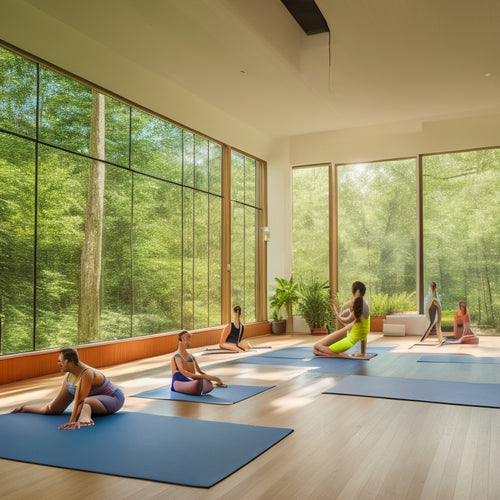Dance Study Explores Identity and Training Secrets
Share
A recent dance study uncovers the intricate dynamics shaping a dancer's identity and skills, revealing the significant impact of social categories, media representations, and informal home training practices. These factors influence not only a dancer's technical proficiency but also their sense of self. The study highlights the need to reevaluate traditional dance education approaches, acknowledging the diverse needs and experiences of dancers. By examining the complexities of dance education, we can move towards a more inclusive and empowering system. As we explore the intricacies of dancer identity and training, we expose the hidden nuances that shape the world of dance.
Key Takeaways
• Dancer identity is influenced by social categories like race, ethnicity, and age, as well as media representations that perpetuate stereotypes and ideals.
• Home training is a significant space for dance education, where family dynamics and cultural values shape dancers' identities and skills.
• Examining training dynamics is crucial to avoid perpetuating cultural values and to create an inclusive and equitable dance education system.
• Recognizing the impact of social categories and media on dancer identity is essential for understanding diverse forms of dance and valuing practitioners.
• Inclusive dance education demands understanding of cultural values and accommodating diverse needs and experiences of dancers to empower them.
Unpacking Dancer Identity
The invocation of the term 'dancer' is contingent upon various social categories, including race, ethnicity, and age, which greatly influence an individual's identity as a dancer across different dance forms and contexts. These social categories shape how one's identity as a dancer is perceived and constructed.
Moreover, media representations play a significant role in perpetuating certain stereotypes and ideals of what it means to be a dancer. By examining the interplay between social categories and media representations, this study aims to unpack the complexities of dancer identity.
This nuanced understanding is essential in recognizing and valuing diverse forms of dance and the individuals who practice them.
The Power of Home Training
Frequently, home training is overlooked as a legitimate space for dance education, despite its significance in shaping dancers' identities and skills. This omission neglects the profound impact of family dynamics and cultural values on a dancer's development.
Home training, often facilitated by family members or friends, provides an intimate setting where cultural norms and values are transmitted and internalized. This informal education shapes not only technical proficiency but also the dancer's sense of self and belonging.
Rethinking Dance Education
Beyond the studio walls, dance education takes on a new dimension, one that necessitates a reevaluation of traditional pedagogical approaches to accommodate the diverse needs and experiences of dancers. This shift prompts a critical examination of training dynamics, which often perpetuate dominant cultural values.
By acknowledging the complexities of dance education, we can work towards a more inclusive and equitable system. This requires a nuanced understanding of how cultural values inform dance pedagogy, and how these values can either empower or marginalize dancers.
Frequently Asked Questions
How Do Cultural Values Influence the Way We Perceive Dance Techniques?
Through a cultural lens, social norms shape dance aesthetics, influencing how techniques are perceived; cultural values inform artistic expression, revealing that cultural context is essential in understanding the nuances of dance techniques and their cultural significance.
Can Non-Professional Dancers Acquire Technique Without Formal Training?
Non-professional dancers can acquire technique without formal training through self-directed learning, fostering personal growth and self-discovery, as individuals navigate cultural values and embodied experiences to develop their unique dance practices.
What Role Do Family and Friends Play in Home Dance Training?
Family and friends play a pivotal role in home dance training, serving as informal support networks that foster personal motivation, instill cultural values, and provide accessible knowledge transmission, ultimately empowering non-professional dancers to acquire technique.
How Does Globalization Impact the Preservation of Traditional Dance Forms?
Globalization's dark underbelly: cultural homogenization threatens to erase traditional authenticity, as local dance forms are watered down and assimilated into a bland, commercialized melting pot, imperiling the very essence of cultural heritage.
Can Recognizing Home Training Challenge Dominant Value Systems in Dance?
Recognizing home training can challenge dominant value systems in dance by centering personal narratives and acknowledging cultural appropriation, thereby democratizing access to dance education and promoting inclusive, culturally sensitive practices.
Related Posts
-

Why Makeup Artists Need Innovative Design Tools
You're pushing the boundaries of makeup artistry, and traditional tools are holding you back. Innovative design tools...
-

Essential Spandex Shorts for Yoga and Pilates
Essential spandex shorts are vital for your yoga and Pilates practice. Look for moisture-wicking technology to keep y...
-

Dance Into Elegance: Black & White Ballet Art
Black and white ballet art epitomizes elegance, sophistication, and artistic expression, providing a timeless and ref...


